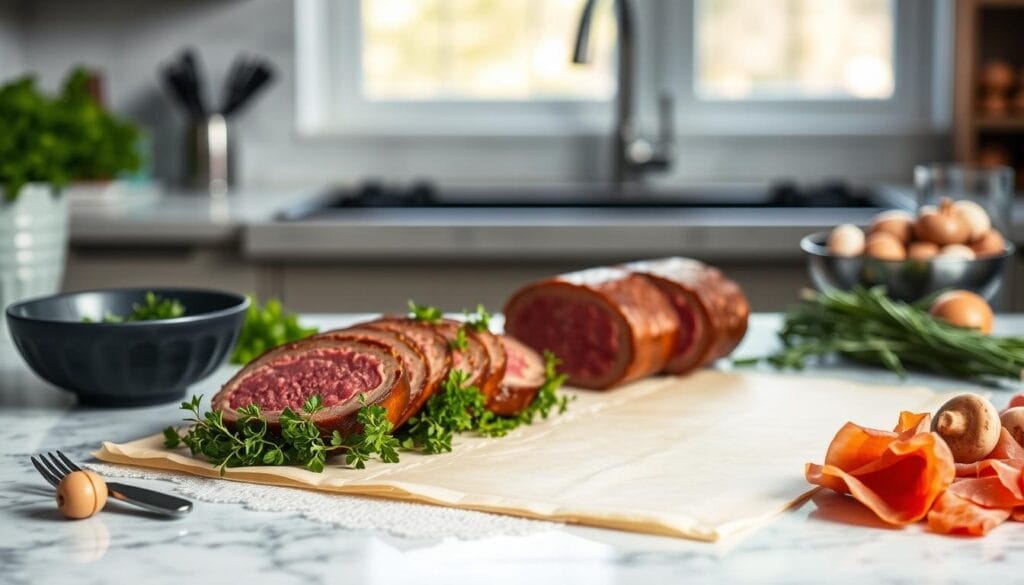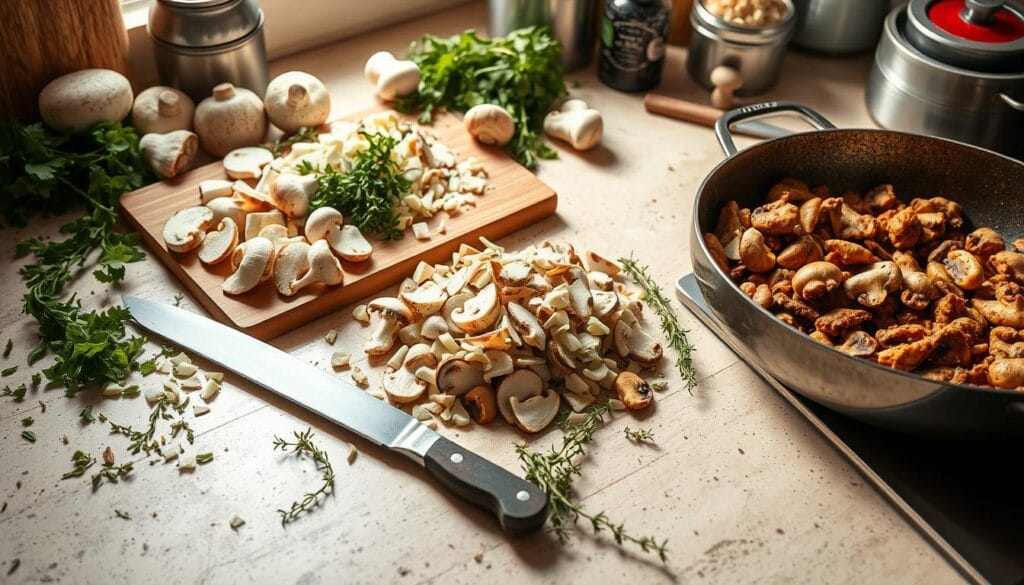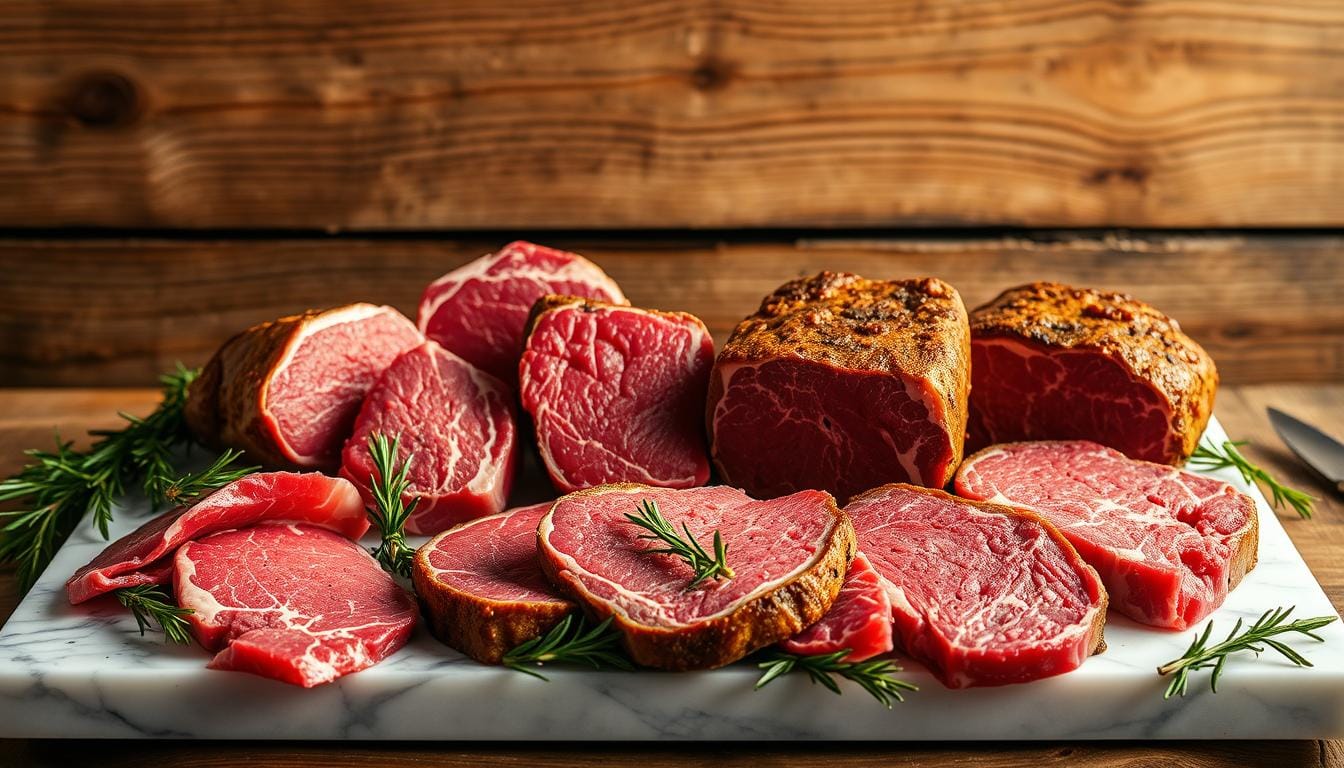Every culinary adventure starts with a perfect ingredient. For Perfect beef wellington cut of meat, that ingredient is the right cut of meat. I recall the first time I saw a chef turn a simple tenderloin into a masterpiece. It left everyone at dinner speechless.
Creating an amazing Beef Wellington is all about the right ingredients and techniques. Your choice of meat is not just about taste. It’s about making a dining experience that goes beyond regular cooking.
Professional chefs say the tenderloin is the best choice for Beef Wellington. It’s tender and has little fat, making it a top choice for a great dish.
Table of Contents
Key Takeaways
- Tenderloin is the premier cut for Beef Wellington
- Meat selection dramatically impacts dish quality
- Understanding meat characteristics is crucial
- Proper preparation enhances tenderloin’s natural qualities
- Technique matters as much as ingredient selection
Understanding Beef Wellington’s Classic Origins
Beef Wellington is a dish with a rich history that has many myths. It’s not true that it was named after the Duke of Wellington. There’s no solid proof linking it to Arthur Wellesley before 1940.
The story of Beef Wellington is quite interesting. It wasn’t mentioned in written records until 1903 at the Angelus Hotel in Los Angeles. It also appeared on a steamship record from November 10, 1899. It became very popular after World War II.
Historical Evolution of the Traditional Recipe
The recipe for Beef Wellington has changed a lot. By the late 1950s, it was seen as a sign of fine cooking. Home cooks wanted to learn how to make it.
“Beef Wellington requires significant skill and dedication, demanding all of the cook’s time and talent.” – Betty Crocker’s Hostess Book, 1967
Key Recipe Components
| Ingredient | Typical Specification |
|---|---|
| Beef Cut | Center-cut tenderloin (2-3 pounds) |
| Mushrooms | Fresh cremini or shiitake (2 lbs) |
| Prosciutto | 6-8 thin slices per tenderloin |
| Pastry | Puff pastry sheets (14 inches square) |
Enduring Culinary Popularity
Julia Child made Beef Wellington famous in America in the 1960s and 1970s. She taught people to use tender fillet and cook it just right. This made the dish a challenge for home cooks.
Today, Beef Wellington still fascinates food lovers. It’s a mix of skill, quality ingredients, and art in cooking.
What Makes Tenderloin the Perfect Choice
Choosing the right meat is key when making beef Wellington. The beef tenderloin is the premier choice for this dish. It brings qualities that make the dish stand out.
So, why is tenderloin the top pick for Wellington? Let’s look at its amazing features:
- Unmatched Tenderness: Tenderloin is the most tender beef, giving a soft texture
- Ideal Shape: Its shape helps in even cooking and looks great
- Lean Composition: It has little fat, offering a clean beef taste
Cooking tenderloin for Wellington needs care. Its soft nature requires gentle handling. Chefs say to keep it simple, letting its natural softness shine.
“The secret to a perfect beef Wellington lies in selecting a top-quality tenderloin and treating it with respect.” – Culinary Expert
Remember, tenderloin is pricier, but it’s worth it. It’s the best for this fancy dish. Its ability to soak up flavors and stay soft makes it unique.
Essential Characteristics of Beef Wellington Cut of Meat
Choosing the right meat is key to a great beef Wellington. The châteaubriand, or center-cut tenderloin, is the top pick for this dish. Knowing what makes your beef Wellington cut special can make your cooking better.
Optimal Size and Shape Requirements
Finding the perfect beef Wellington cut is important. A whole tenderloin can be up to 24 inches long. But, the châteaubriand is the best for consistent results. It’s the center-cut section that works best.
This part of the meat has:
- A uniform shape
- Enough for 6 people
- Even thickness for cooking
Fat Content Considerations
Fat content is crucial when cooking beef Wellington. The tenderloin is lean, so it needs special care to stay moist and flavorful. Here are some nutritional facts to keep in mind:
| Nutrient | Per Serving | Daily Value |
|---|---|---|
| Total Fat | 100g | 128% |
| Saturated Fat | 36g | 180% |
| Protein | 46g | 92% |
Texture and Tenderness Factors
The success of your beef Wellington depends on the meat’s tenderness. The châteaubriand is very tender, making it a great choice. Proper preparation is key to keeping the flavor and texture.
“The secret to a perfect beef Wellington lies in selecting the right cut and treating it with respect.” – Culinary Experts
Preparing Your Tenderloin for Wellington
Beef Wellington starts with picking the right beef tenderloin. You aim to make a dish that needs careful preparation. A 2-pound tenderloin is the perfect size for this classic dish.

- Trimming the silverskin completely
- Removing excess external fat
- Tying the meat to maintain its shape
- Chilling before initial searing
When trimming your tenderloin, be precise. Use a sharp knife to remove the tough, silvery membrane. This makes your Wellington tender and smooth.
“Precision in preparation determines the excellence of your Beef Wellington” – Professional Chef Recommendation
To get your Beef Wellington just right, follow these steps:
- Pat the tenderloin dry with paper towels
- Season generously with salt and pepper
- Let the meat rest at room temperature for 30 minutes
- Tie the tenderloin with butcher’s twine at 1-inch intervals
Chill the tenderloin before searing to keep its shape. Put it in the fridge for 15-20 minutes before searing it at high heat.
The Role of Proper Seasoning and Searing
Learning to cook beef wellington starts with seasoning and searing the beef tenderloin. The right methods can turn a simple cut into a dish that wows everyone. It makes the whole dish taste better.
Seasoning the beef tenderloin is an art that needs care. Chefs say to use about 1/2 teaspoon of salt and 1/4 teaspoon of black pepper for each steak. These steps help the meat soak up more flavor.
Temperature Control Techniques
When making beef wellington, keeping the temperature right is key. Here’s how to sear it well:
- Use medium-high heat (around 375°F)
- Make sure the oil is almost smoking
- Watch the pan’s temperature closely
Seasoning Methods and Timing
Season the beef before you sear it. A good trick is to dry the beef first. This helps make a great crust. Here are some seasoning tips:
- Season well 30 minutes before cooking
- Use kosher salt for better flavor
- Freshly ground black pepper adds depth
Searing Best Practices
Searing makes the outside tasty and keeps the inside juicy. Spend 2-3 minutes searing each side in 1 tablespoon of oil like canola.
“The secret to a perfect beef wellington is in the sear – it’s where flavor truly begins.” – Professional Chef
| Technique | Details | Time/Temperature |
|---|---|---|
| Seasoning | Salt and Pepper | 1/2 tsp salt, 1/4 tsp pepper |
| Searing | Medium-High Heat | 2-3 minutes per side |
| Oil | Canola or Grapeseed | 1 tablespoon |
By using these tips, you’ll get a beef wellington with a perfectly seasoned and seared beef tenderloin. It will be both tasty and tender.
Mastering the Mushroom Duxelles Layer

Making the perfect mushroom duxelles is key to a great Beef Wellington. This layer turns a simple dish into a work of art. It’s a vital ingredient that brings depth and richness to the dish.
To make an amazing duxelles, start with the right mushrooms. Portobello mushrooms are best for their strong flavor. It’s important to dry them well to avoid a soggy pastry.
- Finely chop 10 large portobello mushrooms
- Sauté in a dry pan until moisture completely evaporates
- Cook until mixture sticks to the pan
“The secret to perfect duxelles is patience and low heat” – Professional Chef
Add extra flavor to your duxelles. Consider these tasty additions:
- Minced shallots
- Fresh thyme
- A splash of brandy
Make your duxelles thick and paste-like. It should be spreadable but still packed with flavor. This ensures your Beef Wellington has the right mix of textures and tastes.
Pro tip: Let the duxelles cool completely before adding it to the beef. This keeps the pastry crisp.
The Important Function of Prosciutto Wrapping
Prosciutto is key in making a traditional beef wellington. It adds flavor and protects the ingredients. This makes your dish perfect.
Moisture Barrier Magic
Prosciutto keeps your beef wellington moist. Its thin layers stop beef juices from soaking the pastry. This keeps the pastry crisp and the inside juicy.
- Prevents pastry sogginess
- Maintains crisp texture
- Protects delicate pastry layers
Flavor Enhancement Properties
Prosciutto also adds a salty, umami flavor. It mixes well with the beef and mushroom duxelles. This makes the dish taste richer and more complex.
“The secret to an exceptional beef wellington lies in its carefully crafted layers” – Culinary Experts
Application Techniques
When wrapping, make sure the prosciutto doesn’t overlap too much. This prevents too much salt. Cover the beef and duxelles evenly to seal them well.
| Prosciutto Wrapping Tips | Recommended Approach |
|---|---|
| Slice Thickness | Paper-thin (approximately 1/4 lb) |
| Overlap Limit | Maximum 1 inch |
| Chilling Time | 30 minutes before baking |
Learning to wrap prosciutto makes your beef wellington amazing. It turns your kitchen into a restaurant.
Pastry Selection and Handling Tips
Choosing the right pastry is key for a great beef wellington. Homemade puff pastry adds a personal touch. Yet, many chefs prefer store-bought for its consistency and time-saving tips.
When picking your puff pastry, keep these points in mind:
- Opt for all-butter puff pastry for rich flavor
- Check for even thickness and minimal cracks
- Ensure pastry is fresh and recently manufactured
Handling the pastry right is crucial. Thaw your pastry carefully – let it sit out for 20-30 minutes before use. This helps avoid cracks and makes rolling easier.
“The secret to perfect puff pastry is gentle handling and cold temperature,” – Professional Pastry Chef
Important pastry techniques include:
- Roll pastry on a lightly floured surface
- Avoid overworking the dough
- Trim edges cleanly for neat presentation
- Seal edges thoroughly to prevent moisture leakage
Some chefs add a thin layer of phyllo dough under the puff pastry. This helps keep the bottom crisp and prevents sogginess.
Temperature Monitoring Throughout Cooking
Mastering beef Wellington cooking tips requires precise temperature control. Your success depends on carefully monitoring the internal temperature of the beef tenderloin throughout the cooking process.
Achieving the perfect beef tenderloin cooking techniques involves understanding temperature ranges and timing. An instant-read or probe thermometer becomes your most crucial kitchen tool for this delicate dish.
Optimal Internal Temperature Goals
For an exceptional beef Wellington, target these internal temperature ranges:
- Rare: 120-129°F
- Medium Rare: 130-134°F (most popular)
- Medium: 135-144°F
- Medium Well: 145-154°F
“The difference of just a few degrees can transform your beef Wellington from extraordinary to ordinary.” – Professional Chef
Resting Period Guidelines
After removing your beef Wellington from the oven, allow it to rest for 10-15 minutes. This crucial step enables the juices to redistribute, ensuring a moist and tender result.
| Cooking Stage | Temperature | Time |
|---|---|---|
| Initial Cooking | 375°F | 22-25 minutes |
| Resting Period | Room Temperature | 10-15 minutes |
Remember, patience is key in beef Wellington preparation. Let the meat rest, and you’ll be rewarded with a perfectly cooked, juicy centerpiece that will impress even the most discerning dinner guests.
Common Mistakes to Avoid
Making the perfect beef Wellington needs precision and attention to detail. Many home cooks face challenges that can ruin this elegant dish. Knowing the common mistakes can help you make a meal that rivals a restaurant’s.
Let’s look at the most important errors to steer clear of:
- Soggy Pastry Pitfalls
- Not chilling the pastry before baking
- Failing to create steam vents
- Applying wet fillings directly to pastry
- Beef Cooking Challenges
- Overcooking the tenderloin
- Skipping the crucial searing step
- Neglecting proper resting time
- Assembly and Presentation Issues
- Uneven pastry thickness
- Improper sealing techniques
- Cutting before appropriate resting period
Temperature control is key in beef wellington cooking tips. Your tenderloin should hit an internal temperature of 120-125°F before wrapping and baking. This ensures a perfectly pink center without overcooking.
“Patience and precision are the secret ingredients to a flawless beef Wellington.” – Professional Chef
Beef wellington preparation requires careful attention. Chilling your assembled Wellington for 15-20 minutes before baking helps keep it intact. Use an egg wash for a golden, crisp exterior that will wow your dinner guests.
Conclusion
Making the perfect Beef Wellington takes dedication, skill, and a good grasp of cooking techniques. Your journey through this classic dish is more than just following a recipe. It’s about diving into a sophisticated cooking experience that turns top-notch ingredients into a remarkable dish.
Beef Wellington is complex and requires patience and precision. You start by picking the right beef tenderloin and managing moisture with mushroom duxelles. Each step is crucial for the final masterpiece. With 1 hour and 15 minutes of prep and cooking at 400°F, you’ll make a meal for four with about 650 calories of pure culinary excellence.
As you get better, remember that mastering Beef Wellington is a rewarding challenge. The key is to cook it to 130°F for a perfect medium-rare. Then, let it rest for 10-15 minutes to let the juices spread. Your hard work turns this complex dish into something achievable, showing that with practice, anyone can make a restaurant-quality meal at home.
Beef Wellington is more than just a meal; it’s a showcase of culinary artistry. Enjoy every step of the process and relish the delicious outcome of your cooking passion.
FAQ
What is the best cut of meat for Beef Wellington?
How difficult is it to make Beef Wellington at home?
What are the traditional ingredients in Beef Wellington?
How do I prevent my Beef Wellington from becoming soggy?
What internal temperature should Beef Wellington be cooked to?
Can I prepare Beef Wellington in advance?
What are some common mistakes to avoid when making Beef Wellington?
Are there vegetarian alternatives to Beef Wellington?
Source Links
- How To Make Beef Wellington Like Gordon Ramsay – https://thefoodieeats.com/beef-wellington-gordon-ramsay/
- What Cut Of Steak Should You Use When Making Beef Wellington? – https://www.yahoo.com/lifestyle/cut-steak-making-beef-wellington-134548947.html
- How beef wellington became a British classic – https://www.nationalgeographic.com/travel/article/how-beef-wellington-became-a-british-classic
- How Do You Eat a Beef Wellington: A Simple Guide to Savoring This Classic Dish – https://www.howtoeatthis.com/stream/how-do-you-eat-a-beef-wellington/
- Beef Wellington – Obsessive Cooking Disorder – https://www.obsessivecooking.com/beef-wellington/
- Is There A Right Cut Of Steak For Beef Wellington? – Chowhound – https://www.chowhound.com/1743994/traditional-steak-cut-beef-wellington/
- The Only Cut Of Meat To Use For A Top Of The Line Pork Wellington – Tasting Table – https://www.tastingtable.com/1639340/best-cut-meat-pork-wellington/
- Chef John’s Individual Beef Wellingtons – https://www.allrecipes.com/recipe/282602/chef-johns-individual-beef-wellingtons/
- What Cut Of Steak Should You Use When Making Beef Wellington? – Food Republic – https://www.foodrepublic.com/1657672/cut-steak-use-beef-wellington/
- Beef Wellington Recipe with Thermal Tips – https://blog.thermoworks.com/beef-wellington-recipe-with-thermal-tips/
- Beef Wellington – https://www.tasteofhome.com/recipes/classic-beef-wellingtons/?srsltid=AfmBOoroBerAt50guuzcdr5mRqtSvIAa-aQ5HGBQn7JRIJE4lgwnwDXL
- Beef Wellington – https://www.foodandwine.com/recipes/beef-wellington
- Mastering the Art of Beef Wellington — COOKINGATFFF (foongfamilyflat) – https://www.cookingatfff.com/recipe-and-tips/mastering-the-art-of-beef-wellington
- Master This Classic Beef Wellington For The Most Impressive Holiday Centerpiece – https://www.delish.com/cooking/recipe-ideas/a58702/easy-beef-wellington-recipe/
- Beef Wellington | Two Plaid Aprons – https://twoplaidaprons.com/beef-wellington/
- How to ‘Wellington’ Basically Any Protein | Lifehacker – https://lifehacker.com/food-drink/how-to-wellington-more-than-beef
- Texas-Style Beef Wellington: Southern Christmas Showstopper – https://www.simplytexan.com/texas-recipes/how-to-make-classic-beef-wellington-this-christmas/
- Beef Wellington for Two – https://somuchfoodblog.com/beef-wellington-for-two/
- Beef Wellington {Quick & Easy} – The Big Man’s World ® – https://thebigmansworld.com/beef-wellington-recipe/
- Beef Wellington – https://www.errenskitchen.com/beef-wellington/
- Beef Tenderloin Temperature Chart! – https://foodieandwine.com/temperature-chart-for-beef-tenderloin/
- Easy Beef Wellington – https://sundaysuppermovement.com/beef-wellington/
- How to Make Beef Wellington Like a Pro – moomrecipes.com – https://www.moomrecipes.com/how-to-make-beef-wellington-like-a-pro/
- Beef Wellington – The Ultimate Guide to an Exquisite Dish – Fruit And Foods – https://fruitandfoods.com/2024/07/17/beef-wellington/
- Beef Wellington Recipe | LynneCurry – https://lynnecurry.com/beef-wellington-recipe/





I’m extremely impressed along with your writing talents
and also with the format on your weblog. Is that this a paid theme or did you modify it yourself?
Either way keep up the nice quality writing, it’s rare to look a great weblog like this
one today. Snipfeed!
Thanks for sharing. I read many of your blog posts, cool, your blog is very good.
Your point of view caught my eye and was very interesting. Thanks. I have a question for you.
Your article helped me a lot, is there any more related content? Thanks!
I don’t think the title of your article matches the content lol. Just kidding, mainly because I had some doubts after reading the article. https://accounts.binance.com/kz/register?ref=K8NFKJBQ
Thanks for sharing. I read many of your blog posts, cool, your blog is very good.